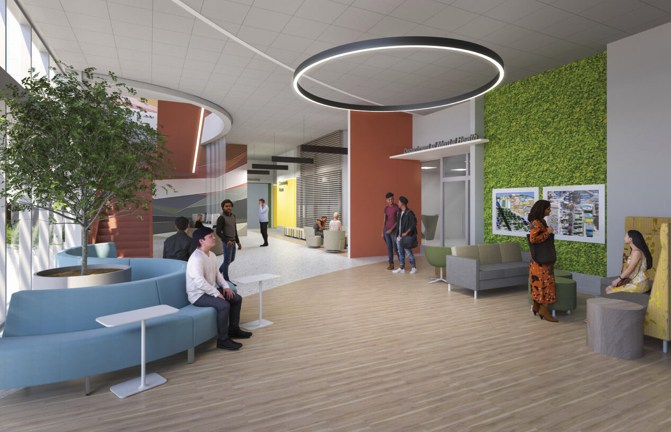Welcome to HMC Architects’ Five in Focus blog series, where we delve into the latest trends, ideas, and innovations shaping the future of architecture and design. This series is a conversation with our design professionals, inviting them to share what’s capturing their attention and offer unique insights.
Julian Lopez, NCIDQ, IIDA, is a senior interiors project designer at HMC. Here, he shares his insights on color forecasting, behavioral health, staying current with design palettes, incorporating art in healthcare settings, and enhancing acoustics and ergonomics for any environment.
1. Color Forecasting – The “New” White
I recently attended a Behr color forecast session and gained some fascinating insights. The perception of white is evolving; it’s transforming from a default choice into a deliberate design accent. In healthcare, the significance and application of the color “white” are also changing, reflecting these broader trends. White is no longer seen merely as a backdrop but as a versatile hue that can create a sense of cleanliness, calm, and sophistication. Designers are experimenting with shades of white, from warm, creamy tones to cool, crisp variations, each bringing a unique atmosphere to a space. This nuanced approach allows white to enhance other colors and textures in a room, making it a powerful tool for creating modern, inviting environments. As we progress, the strategic use of white will continue to shape aesthetic and functional design aspects in healthcare and beyond.

2. Behavioral Health and FF&E
Behavioral Health is addressing critical issues like homelessness and has become a buzzword in the industry. Every firm involved in healthcare design is eager to participate in this movement. At the HCD conference last year, it was clear that many furniture, fixtures, and equipment (FF&E) vendors are now producing items specifically for Behavioral Health, aiming to capitalize on this trend. These vendors focus on creating products that meet the unique needs of behavioral health environments, emphasizing safety, durability, and comfort. Integrating therapeutic design elements, such as calming color palettes, soft textures, and secure yet aesthetically pleasing furniture, is becoming standard. Moreover, the push towards innovative, patient-centered solutions drives collaborations between designers, clinicians, and patients to ensure that the spaces are functional and conducive to healing and well-being. This collaborative approach leads to the development of environments that can better support mental health treatment and address complex issues like homelessness, aiming for holistic and sustainable care solutions.

3. Keeping up with Palettes
Design trends constantly evolve, prompting questions about the sustainability of “timeless” projects. One of our healthcare clients exemplifies this evolution; they recently reinvented their “playbook palette,” which we collaborated on. This new palette accommodates various projects while adhering to budget constraints. Palettes often set the pace in the hospitality sector, with other industries following suit. Moreover, integrating innovative materials and eco-friendly options has become paramount, reflecting a broader industry shift toward sustainability. By staying attuned to these changes, we ensure our designs remain relevant and anticipate future needs and preferences, delivering enduring value to our clients.
4. Adequate Art in Healthcare
Art significantly influences healthcare environments, impacting both patients and providers. With substantial budgets, our Harbor-UCLA Medical Center client commissioned two major artists as part of their new redevelopment program, highlighting the necessity for careful analysis due to the potential positive and negative effects on patients. Whether art should blend with the overall design or stand out is crucial in healthcare settings. Art can provide therapeutic benefits, reducing stress and anxiety, promoting healing, and creating a more welcoming atmosphere. Conversely, poorly chosen artwork might evoke negative emotions or discomfort. Thus, the selection process should involve input from medical professionals, patients, and artists to ensure the art aligns with the healthcare goals and the emotional well-being of its audience.

5. Acoustic and Ergonomically Soundproof Environments
In the post-COVID era of hybrid work, the importance of our work environment, especially when working from home, has increased. Factors such as acoustics, equipment quality, and Wi-Fi are more critical than ever. Investing in these aspects is investing in oneself. Enhancing acoustics and ergonomics can significantly improve the surrounding design, leading to a more effective and pleasant work environment. Personalizing the workspace to reflect individual preferences and needs can boost productivity and job satisfaction. Creating a dedicated, well-organized workspace free from distractions fosters a better work-life balance. Furthermore, incorporating natural light, indoor plants, and aesthetically pleasing elements can enhance mood and overall well-being, making remote work not just a necessity but a more enjoyable and sustainable experience.

